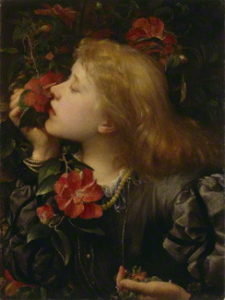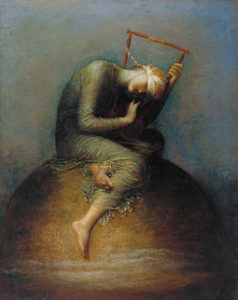20 July 2017
Watts 200: Celebrating England’s Michelangelo
The Watts Gallery, Guildford, Surrey (20 June – 26 November).
By William Morton

This exhibition celebrates the two hundredth anniversary of the birth of George Frederic Watts (1817 – 1904). To call him ‘England’s Michelangelo’ is perhaps over-doing it but he is an important artist, even if he has never quite regained the status he enjoyed in his lifetime. He was twice offered a baronetcy and was an original member of the Order of Merit. His achievements were all the more remarkable because his origins were humble and he had little formal education. Nevertheless, he was friends with such eminent Victorians as Tennyson, Swinburne and Lord Leighton. He was a sculptor as well as a painter and produced some important frescoes.
The basis of his success was portrait painting, and the exhibition includes some appealing and striking ones such as that of the young actress Ellen Terry, entitled Choosing, and another of his friend, the philanthropist Jane ‘Jeanie’ Elizabeth Hughes, both of which show a clear Pre-Raphaelite influence. One of Cardinal Manning with a skull-like head is said to have inspired Picasso. Swinburne said Watts only painted portraits ‘for three reasons – friendship, beauty and celebrity’. There seems nothing wrong with that.
Watts is probably better known for his symbolic and allegorical paintings. He himself said that he painted ideas, not things. The exhibition includes some well-known examples such as Hope depicting a blindfolded girl sitting on a globe holding a lyre with broken strings (allegedly Barack Obama’s favourite painting), and Found Drowned showing a woman’s corpse by the Thames with Waterloo Bridge visible through smog in the background. Again, there is a hint of the Pre-Raphaelites, but they are individual and striking works. Some of his symbolic paintings are of subjects which seem out of touch with modern thinking. Paintings such as Love steering the Boat of Humanity, The Court of Death and Whither goes Thou Satan strike an old-fashioned note and this may explain Watts’ current comparative lack of popularity.

What does seem clear is the confidence and public spirit which he demonstrated in his lifetime. He believed that art could change lives and made a practice of giving paintings away including a large number to the Tate (it seems clear that he was financially secure). One in the Exhibition, Love and Life, he gave to the United States to encourage a kinder political culture. In it, Love is an angel sheltering Life as a young woman with his wings and guiding her. It used to hang in the White House. It is tempting to imagine Donald Trump staring at it with his mouth open, but it would appear it was removed before his time. Watts painted a huge fresco for free in Lincoln’s Inn with a typically Wattsian title, Justice; a Hemicycle of Lawyers. He was also responsible for establishing Postman’s Park in the City to honour ordinary people who saved the lives of others.
Watts’ sculptures, like his paintings, tend to be large scale. On show is the plaster model on which he worked for many years for Physical Energy, an impressive sculpture of a naked man on a horse peering into the distance which is well-known as it located in Kensington Gardens. Watts himself said it was ‘a symbol of that restless physical impulse to seek the unachieved in the domain of material things’.
Watts’ second wife deserves a mention. His first marriage to Ellen Terry took place when he was 46 and she was a teenager, and lasted less than a year. He waited another 20 years before having another go, marrying Mary Fraser Tytler, a Scottish potter. The Watts Gallery is part of a complex which includes a remarkable mortuary chapel designed by Mary. It is built of terracotta bricks and elaborately decorated inside and out and well worth a visit.
Watts had a very individual approach and the Exhibition shows that he was great artist, even if his star is not as bright as it once was.
If you enjoyed this article please share it using the buttons above.
Please click here if you would like a weekly email on publication of the ShawSheet

